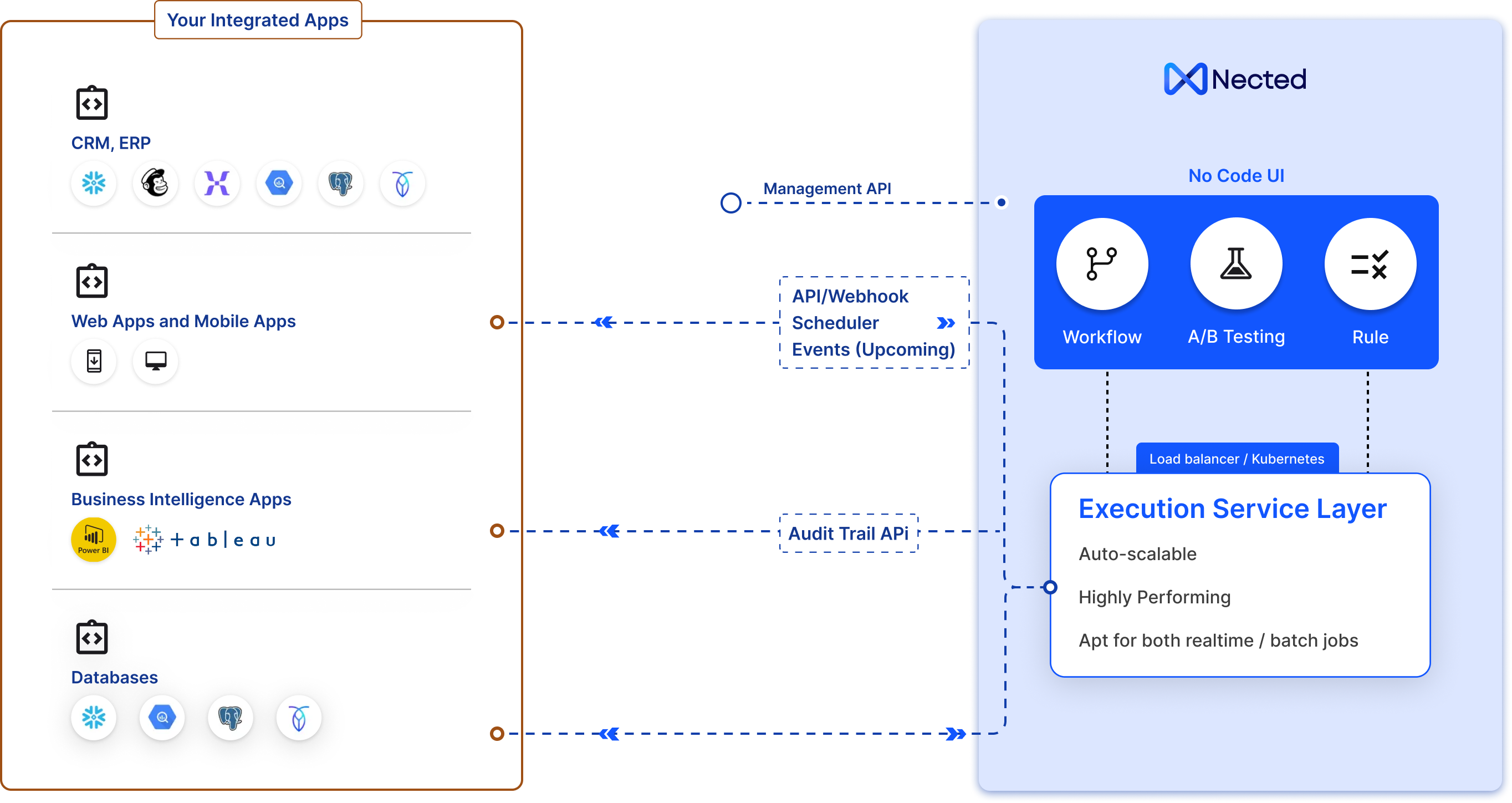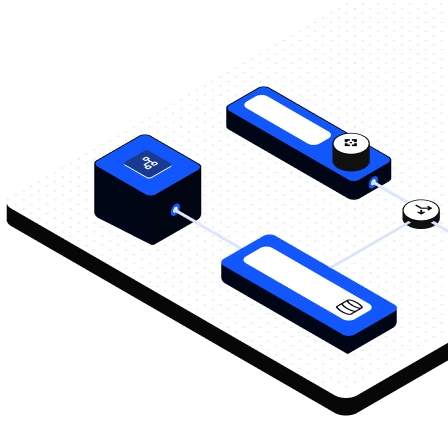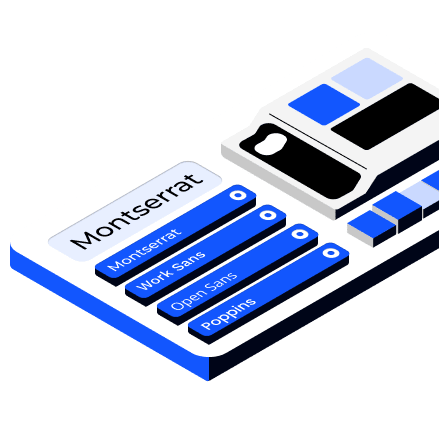
Underwriting backlogs and manual spreadsheets delay approvals and lose enterprise deals — often costing teams weeks of lost revenue.

Scorecards locked in code require developers for every policy tweak, blocking price/term optimization and delaying campaigns.
.webp)
Non-personalized, static scores ignore customer lifecycle signals and external risk data, missing revenue opportunities and increasing write-offs.
.webp)
Teams lack the ability to backtest new scoring rules on historical data or run shadow traffic, causing errors and regulatory exposure when policies change.

Legacy engines struggle with burst volumes and complex multi-source inputs, increasing latency and operational risk.

Disparate ERPs, CRMs and bureaus create a fragmented view of counterparty risk — leading to suboptimal credit limits and higher defaults.

Enable credit, product, and risk teams to author scorecards and policies visually — instantly update weighting, thresholds, and outcomes without code.

Configure campaigns, seasonal credit terms or emergency policy changes in hours and roll out safely with versioning and rollback.

Apply global or segment-specific limits, dynamic thresholds, and watchlists to control exposure across customers, partners, or geographies.

Validate changes with historical backtests and shadow traffic; run thousands of live decisions per second with predictable SLAs.
.webp)

Seamlessly integrate with any system using simple API-based connectors. No need for complex configurations—connect databases, third-party services, and internal tools with just a few clicks.
.webp)
Leverage a powerful rule engine with multiple rule types, including Simple Rules, Decision Tables, Decision Trees, Rule Sets, and Rule Chains to handle complex logic effortlessly.
.webp)
Automate workflows with Action, Rule, Workflow, Code, Database, and REST API Nodes, while Loop, Delay, and Switch Block manage execution.

Efficiently oversee the entire rule and workflow lifecycle with built-in versioning, rollback capabilities, and staging environments, ensuring seamless transitions from testing to production without disruptions.
.webp)
Deploy Nected anywhere—choose multi-region cloud hosting for high availability or self-host on your infrastructure for complete control and compliance.

Gain full visibility into your decision rules and workflows with audit trails features, and real-time dashboards. Stay compliant and track every change with ease.

Deliver a fully white-labeled experience with embedded user functionality. Use Nected as your own branded decision engine.

Operate with confidence using enterprise-level security, role-based access control, and scalable infrastructure that ensures data integrity and performance even at scale.

Deploy intelligent AI Agents to automate document extraction, text classification, data enrichment, or any other domain-specific task. Build your own agents or plug in pre-trained ones directly into your workflows.

Integrate APIs, databases, and AI models like OpenAI or Vertex in minutes—no coding, just simple drag-and-drop setup.

Nected provides full parity with enterprise rule engines like Pega and DecisionRules while prioritising speed-to-value and business control. Unlike heavyweight platforms, Nected delivers a visual, no-code score builder, zero-downtime policy rollouts, built-in simulation/backtesting, and versioned audit trails — enabling credit teams to configure, test, and deploy policies in hours instead of months. For large-scale decisioning, Nected supports the same enterprise capabilities (role-based access, SLA-oriented throughput, and on-prem/cloud deployment options) while reducing implementation & TCO by 40–70% for most customers.
Business users and underwriters ramp in days. Nected’s drag-and-drop score builder, pre-built connectors (ERP, CRM, banking APIs), and templated rule libraries mean credit teams can author and test scorecards with minimal training — typical time-to-first-decision is under 7 days.
Nected is built for enterprise scale: multi-region deployment, horizontal autoscaling, and throughput benchmarks supporting 100,000+ decisions per minute with predictable latency. The platform supports asynchronous pipelines, batching, and priority queues to ensure mission-critical scoring runs reliably under peak load.
Nected stores configurable transactional and audit data necessary for decisioning and compliance. Security controls include encryption-at-rest and in-transit, role-based access control, audit logs, SSO integrations, and support for SOC 2/ISO/GDPR compliance frameworks. Customers can choose cloud-hosted or on-prem deployments for stricter data residency requirements.
Yes — Nected includes sandboxed simulation, historical backtesting, and shadow traffic modes so credit teams can validate rule changes against real datasets before promoting to production. Built-in metrics and explainability traces let teams measure lift and detect regressions instantly.
Nected offers REST APIs, webhooks, and pre-built connectors for Salesforce, SAP, Oracle, core banking APIs, and common credit bureaus. Integration templates and an API-first approach enable rapid onboarding with clear mapping guides and secure authentication patterns.
Invocations refer to the number of times your workflows/rule is triggered via API, cron or other trigger. It will count the parent rule/workflow and can have as many rules, nodes within it. This metric is often used for billing purposes. Compared to other products, invocations as a billing metric can be more cost-effective and transparent, aligning closely with your actual usage and needs. It ensures you pay for the value you receive, rather than flat rates or less relevant metrics.
If you exceed, you'll be charged based on additional usage and will be added in your monthly charge. In case of payment failure after grace period, your plan will be reverted to free trial limiting your monthly execution and # of rules/flows as per free plan, however all your existing rules/workflow data would be kept intact.
Firstly, we do not have a vendor lock-in, so you can cancel anytime you want. However, if you decide to cancel once your subscription for a given period has started then you would be able to cancel at the time of the next billing cycle only.
Yes, you can typically upgrade your Nected plan at any point during your billing cycle. The upgrade process is usually straightforward, often involving just a few clicks in your account settings. Upgrading mid-cycle may involve prorated charges for the higher-tier service.
The best plan depends on your specific needs, such as the expected number of invocations, the complexity of your workflows, and the level of support you require. It’s a good idea to start with a basic plan and upgrade as your needs evolve, especially if you're new to Nected. Moreover, you can also write to us at assist@nected.ai and we will help you figure out the best plan for your brand.
Yes, Nected usually offers assistance in setting up and creating a Proof of Concept (POC), especially under certain plans. This assistance can include access to customer support, documentation, and possibly dedicated account management.
The Startup and Growth plans typically provide basic to enhanced support, including access to customer service through email or chat, a knowledge base, and possibly community forums. Response times and the extent of personalized assistance may vary between these plans.
The on-premise plan generally offers the most comprehensive support, including dedicated account managers, 24/7 support, and tailored assistance for deployment, maintenance, and troubleshooting. This plan is best suited for businesses with extensive, mission-critical use of Nected.